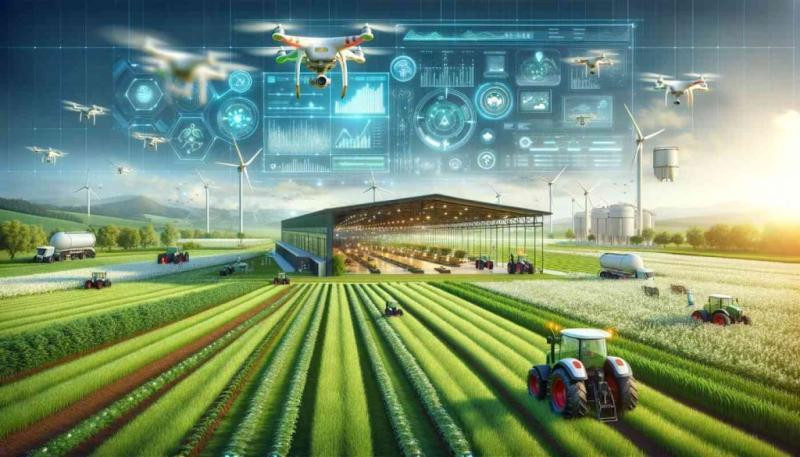As farming becomes increasingly consolidated and technology-driven, a new business model is emerging that allows farmers to remain competitive by focusing on their core competencies while outsourcing other functions. This model, known as Farming As a Service (FaaS), provides a va
riety of services to farmers on an a la carte basis.
Agricultural Megatrends Driving the Need for Change
Global population growth and rising income levels are fueling increased demand for food worldwide. At the same time, farming is becoming more consolidated and industrialized as small and mid-sized farms struggle with economies of scale. Fewer farms are managing more land and livestock to maximize productivity and profitability. Technology is also rapidly transforming agriculture through precision farming tools, autonomous machinery, and analytics. However, the high costs of these technologies put them out of reach for many individual farmers.
Another major trend is the shifting consumer preferences for sustainable and transparent farming practices. Consumers want to know how their food is produced in terms of environmental and animal welfare standards. Meeting these evolving expectations requires new expertise and certifications that smaller operators may lack.
Rising Costs and Complexity Leave Farmers Seeking New Options
The confluence of these megatrends has led to rising operational costs, complex compliance requirements, and pressure to adopt new technologies just to stay in business. However, the necessary investments in equipment, employee training, certifications and technology solutions are prohibitive for many small- and medium-sized farms.
At the same time, unpredictable weather patterns, export markets, and commodity prices have made farming a highly volatile business. The risks and uncertainties leave farmers struggling to generate consistent profits and returns on investment. As a result, many are reaching the limits of what they can reasonably manage on their own.
Farming As a Service Provides a Flexible Solution
Enter Farming As a Service: a business model that allows individual farmers and cooperatives to outsource various non-core functions and expenses on an ongoing, pay-per-use basis. Farmers can subscribe to specific technology, operational or marketing services rather than shouldering the entire costs upfront or on their own.
Key services available through the FaaS model include:
Technology Services
- Precision agriculture tools (drones, sensors, software, etc.) for tasks like crop monitoring, soil analysis and automated equipment operation. Data capture and analytics allow for more insightful decision making.
- Online marketplaces that give farmers access to machinery, equipment and specialized labor on an as-needed basis rather than requiring ownership. This reduces capital costs.
Operational Services
- Soil testing and consultancy on nutrient/fertilizer management, crop rotation planning, and optimization of yields.
- Livestock monitoring solutions using biosensors, GPS trackers and health diagnostics to ensure optimum animal welfare and productivity.
- Labor outsourcing for tasks such as harvesting if farms face seasonal workforce shortages. Mobile apps can connect farmers to contingent workers.
Certification and Compliance
- Assistance with paperwork, record-keeping and obtaining certifications for sustainable/organic practices, food safety standards, and other regulatory requirements that vary between markets.
- Advisory services on issues like tariffs, quotas and other trade regulations for exporting crops and meat to international buyers.
Marketing and Distribution
- Sales and distribution channels to grocery stores and food brands that guarantee purchase of harvests at a predetermined price to reduce price risk.
- Promotion of farms and their products online to attract chefs and consumers directly through platforms like community-supported agriculture (CSAs).
The Benefits of Outsourcing to Experts
By outsourcing operational functions to Farming a Service providers, individual farmers and cooperatives gain several important advantages:
- Access to advanced technologies and expertise they could not otherwise afford or develop on their own, allowing them to boost yields, efficiency and decision-making.
- Variable operating costs that scale with usage rather than big capital outlays, reducing financial burdens.
- Focus on core farming activities instead of diversifying into support services outside their primary skill set.
- Certainty of selling harvests through marketing/distribution channels provided by FaaS partners.
- Compliance with evolving regulations and voluntary standards through guidance from certification specialists.
- Flexibility to scale services up or down as needed, addressing the seasonal nature of agriculture.
The Future of FaaS
As demand for Farming a Service grows, we can expect dedicated FaaS companies and agricultural cooperatives to emerge that aggregate technologies, service offerings, marketing relationships and group purchasing power on behalf of farmers. Mature players in the space may integrate additional services across the full farm-to-table supply chain over time.
In Summary, combined with advanced analytics of massive on-farm and environmental data, Farming a Service has the potential to revolutionize agriculture by boosting sustainability and rural prosperity through a thriving independent farming sector. It heralds an exciting new future where technological progress and specialized expertise empower, rather than replace, farm operators.
About Author:
Ravina Pandya, Content Writer, has a strong foothold in the market research industry. She specializes in writing well-researched articles from different industries, including food and beverages, information and technology, healthcare, chemical and materials, etc. (https://www.linkedin.com/in/ravina-pandya-1a3984191)
*Note:
1. Source: Coherent Market Insights, Public sources, Desk research
2. We have leveraged AI tools to mine information and compile it

